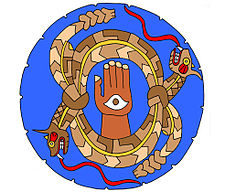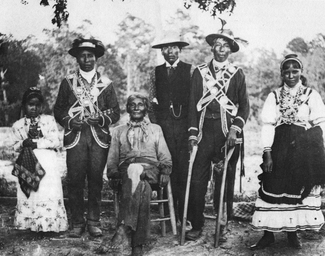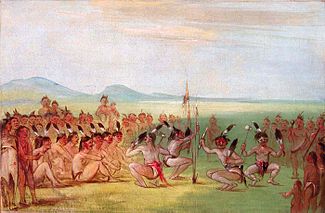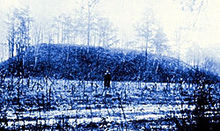- Choctaw mythology
-
Choctaw mythology is related to Choctaws who are a Native American people originally from the Southeastern United States (Mississippi, Alabama, and Louisiana). In the 19th century, Choctaws were known as one of the "Five Civilized Tribes" because they had integrated numerous cultural and technological practices of their European American neighbors. Today the Choctaws have four tribes, the Mississippi Band of Choctaw Indians, Choctaw Nation of Oklahoma, Jena Band of Choctaw Indians, and the MOWA Band of Choctaw Indians.
The Choctaw and their ancestors have lived in the Mississippi region for about 4000 to 8000 years. Thousands of years of myth and story-making have contributed to a rich collection of history that spans the centuries. The Choctaw continue to tell and write about the legends that many have experienced in the American Deep South.
Contents
Choctaw Creation
First version
The Choctaw who remain in Mississippi tell this story as an explanation of how they came to the land where they live now and of how Nanih Waiya Mound came to be.
Two brothers, Chata and Chicksah led the original people from a land in the far west that had ceased to prosper. The people traveled for a long time, guided by a magical pole. Each night, when the people stopped to camp, the pole was placed in the ground and in the morning the people would travel in the direction in which the pole leaned.
After traveling for an extremely long time, they finally came to a place where the pole remained upright. In this place, they laid to rest the bones of their ancestors, which they had carried in buffalo sacks from the original land in the west.
The mound grew out of that great burial.
After the burial, the brothers discovered that the land could not support all the people. Chicksah took half the people and departed to the North and eventually became the Chickasaw tribe.
Chatah and the others remained near the mound and are now known as the Choctaw.[2]
Second version
At the beginning there was a great mound. It was called Nanih Waiya. It was from this mound that the Creator fashioned the first of the people. These people crawled through a long, dark cave into daylight and became the first Choctaw.
Supernatural Native America
Some early writers, and in later times Cushman and Bushnell, report that the Choctaws believed in a great good spirit and a great evil spirit. It seems that there were a number of supernatural beings mentioned in Choctaw historical accounts. In addition to the native language for what would today be termed God and Devil, the Choctaws believed they had many other "powerful beings" in their midst.
Ancient religion
The Great Spirit (or God) of the Choctaw went by various names. Rev. Alfred Wright also said God was referred to as "Nanapesa," "Ishtahullo-chito" or "Nanishta-hullo-chito," "Hustahli," and "Uba Pike" or "Aba."[3][4] "Shilup chitoh osh" is a term anglicized to mean The Great Spirit. "Chitokaka" means The Great One. The terms lshtahullo or nanishtahullo is applied to anything thought to possess some occult or superior power - such as a witch.
“ Anthropologist theorize that the Mississippian ancestors of the Choctaw placed the sun at the center of their cosmological system. Mid-eighteenth-century Choctaws did view the sun as a being endowed with life. Choctaw diplomats, for example, spoke only on sunny days. If the day of a conference were cloudy or rainy, Choctaws delayed the meeting, usually on the pretext that they needed more time to discuss particulars, until the sun returned. The sun made sure that all talks were honest. The sun as a symbol of great power and reverence is a major component of southeastern Indian cultures. ” —- Greg O'Brien, Choctaws in a Revolutionary Age, 1750-1830[5]
"Hushtahli" is from "Hashi" (Sun) and "Tahli" (to complete an action). "Hushatahli" is believed to have originated as a Choctaw term without European influence; the Choctaw were believed to be sun worshipers. Fire was the "most striking representation of the sun", having intelligence, and was considered to be in constant communication with the sun.
Interactions between animals and people
 A digital graphic based on a ceremonial stone palette found at the Moundville Archaeological Site in Moundville, Alabama
A digital graphic based on a ceremonial stone palette found at the Moundville Archaeological Site in Moundville, Alabama
The Choctaw venerated Sinti lapitta was a horned serpent which visited unusually wise young men.
Little People and other human-like creatures
They believed in a little man, about two feet high, who dwelled alone in the thick, dark woods. The little man was called Bohpoli or Kowi anukasha, both names being used alone or together. The translation of Bohpoli is the "Thrower". The translation of Kowi anuskasha is "The one who stays in the woods", or to give a more concise translation, "Forest Dweller". Little man can be compared to the European counterparts- Dwarfs, Elves, Gnomes, and Leprechauns. Little people sighting occur all over the world. One such example includes sightings in South America.
The little wood sprite was known to be rather mischievous, but not malicious. The Choctaws believed that he often playfully threw sticks and stones at them. All unexplained sounds heard in the woods were attributed to Bohpoli, believing he took a special pleasure in hitting the pine trees to create noise.
Bohpoli was never seen by the common Choctaws, only the prophets and doctors. The Indian doctors would report that Bohpoli assisted them in the manufacture of their medicines. Some stories even give the account that bohpoli would "steal" little children and take them into the woods, to teach them about herbs and medicines. After returning the children to their homes, Bohpoli would leave them alone, letting them grow up to become doctors of the tribe.
An interesting being mentioned in some of the history writings is Kashehotapalo, a combination of man and deer who delighted in frightening hunters. He was much admired for his speed and agility. If the Choctaws angered Kashehotapalo, he would race ahead of them and warn the enemy or animals being hunted.
Okwa Naholo or Oka Nahullo (white people of the water) dwelled in deep pools and had light skins like the skins of trout. They were believed to sometimes capture human beings whom they converted into beings like themselves.
Hoklonote was a bad spirit who could assume any shape it desired; it was considered to read people's thoughts.
Shadow-like beings
The Choctaws have stories about Shadow beings. "Nalusa chito", also known as an "Impa shilup," was the soul-eater, great black being, or devil.[3] If people allow evil thoughts or depression to enter their minds, it would creep inside them and eat their soul.
"Nalusa Falaya" (long black being) resembled a man, but with very small eyes and long, pointed ears. He sometimes frightened hunters or transferred his power of doing harm. Some believed that "Nalusa Falaya" preferred to approach men by sliding on his stomach like a snake.
"Hashok Okwa Hui'ga" (Grass Water Drop) was believed to have a connection to what is termed will-o'-the-wisp. Only its heart is visible, and that only at night. If anyone looks at it he is led astray.
It was also believed that every man had a "shilombish" (the outside shadow) which always followed him, and "shilup" (the inside shadow, or ghost) which after death goes to the land of ghosts. The "shilombish" was supposed to remain upon the earth, and wander restlessly about its former home, often moaning, to frighten its surviving friends, as to make them forsake the spot, and seek another place to live. It was also supposed to assume the form of a fox, or owl; and by barking like the one, and screeching like the other at night, cause great consternation, for the cry was considered ominous of bad things. The Choctaws could tell between the "shilombish" and animals it imitates. When a fox barks, or an owl screeches, another fox or owl replies. But when the "shilombish" imitates the sound of either animal, no response is given.
Birds of the dark
Ishkitini, or the horned owl, was believed to prowl about at night killing men and animals. Many believed that when ishkitini screeched, it meant sudden death, such as a murder. If the ofunlo (screech owl) was heard, it was a sign that a child under seven in that family was going to die, because in size, it is a small owl. If opa (a common owl) perched in a barn or on trees near the house and hooted, it foreboded death among the near relatives.
Biskinik, the sapsucker, was known as the newsbird. If he landed on a tree in their yard early in the morning, some "hasty" news would come before noon. If he perched there late at night, the news would come before morning.
Animal explained occurrences
Animals figure significantly in Choctaw mythology, as they do in most Native American myth cycles. For example, in Choctaw history, solar eclipses were attributed to black squirrels, and maize was a gift from the birds [1]
Heloha (thunder) and Melatha (lightning) were responsible for the dramatic thunderstorms. In Choctaw mythology, they were two huge birds. Heloha would lay her giant eggs in the clouds and they would rumble as they rolled around atop the clouds. Despite his size, her mate, Melatha, was extremely fast and left a trail of sparks as he streaked across the sky.
See also
References
- ^ "Eagle Dance, Choctaw." Luce Foundation for American Art. (retrieved 7 September 2010)
- ^ Taken from Choctaw Creation Myth where it is listed as being in the public domain
- ^ a b Swanton, John (1931). "Choctaw Social and Ceremonial Life". Source Material for the Social and Ceremonial Life of the Choctaw Indians. The University of Alabama Press. p. 195. ISBN 0817311092.
- ^ Jobes, Gertrude. Dictionary of Mythology Folklore and Symbols. New York:The Scarecrow Press, 1962.
- ^ O'Brien, Greg. "Choctaw and Power". Choctaws in a Revolutionary Age, 1750-1830. University of Nebraska Press.
External links
- Grandmother Spider Steals Fire - creation myth of the Choctaw People of Tennessee and Mississippi
- Choctaw legends and stories
- Choctaw Creation Myth
- Shampe (Bigfoot like creature)
Choctaw Federally recognized tribes Culture Culture · Freedmen · Language · Religion · Bishinik periodical · Choctaw Tribal School System · Green Corn Ceremony · Stomp danceHistory Politics and law Categories:- Mythology of the indigenous peoples of North America
- Creation myths
- Choctaw
Wikimedia Foundation. 2010.




